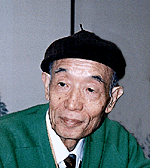First, let's
take a look at Rosanjin's views on cookery.
By chance, I met the chef of "Hoshioka Saryo",
a restaurant that Rosanjin once ran, and I had the opportunity
of hearing stories, straight from the horse's mouth, about the
time when these two men worked together. The chef was Okita
Matsuura, who is now at "Chujinzo", in the
famous Akaina City.
Matsuura is the only person who can tell us about Rosanjin,
the chef, and his style of cookery at that time. Through the
stories that Matsuura told me, I would like to show you
Rosanjin's views on cookery, which revolutionized Japanese
cuisine.
Matsuura entered the field of cookery at sixteen years
of age, and after only six years in the trade he was elevated
to a position at "Hoshioka Saryo", which was
said to be the best "members only" restaurant of that
time. This is hard to believe, but is, nevertheless, true. The
reason is very simple. Rosanjin liked the way he seasoned
food. Before Rosanjin would recognize someone as a chef,
they would be subjected to thorough testing, as follows.
When anyone applied for employment at Hoshioka, they
would have to do a test, conducted by Rosanjin. The test
was to cook at Rosanjin's house in Kamakura. The
ingredients were just the head and bony parts of fish - the head
of a sea bream or the bones of a pike eel. The applicant was
told to go out into the field behind the house for the vegetables.
In those days Kamakura was very rural and had no gas.
They used to cook with charcoal on a "shichirin"
(a drum containing charcoal with a grill on top, on which the
food was cooked). Those who were sent home after one day were
not employed, but if someone was asked to stay and cook for a
second day, he had passed the test. They say that Matsuura
spent over twenty days there, so he was completely accepted by
Rosanjin.
Rosanjin used to say, "Cookery is a splendid art
because people can be greatly moved by the flavours of food.
Therefore, it is most important for a chef to understand flavours
well. Anyone can become good at preparing sashimi or cooking
tempura if they practise for many years, but understanding
flavours is a talent one must be born with. It cannot be learned
with time." (Okita Matsuura, "Rosanjinji
wa hitonari kokoronari", NTV). Rosanjin always
emphasized that, in cookery, the flavour is the most important
thing.
While Rosanjin was emphasizing the importance of flavour,
there were many restaurants at that time, in which presentation
was regarded as more important than flavour. I once heard from
a certain chef that in restaurants in those days it was not so
much the food that the guest was meant to enjoy, but drinking
sake and watching the musical performances of geisha.
"Cookery" took on a new meaning. Food was often made
into a work of art to make it attractive to guests, and it was
often jellied, so that it could be eaten some time after it was
served. Rosanjin probably wanted to say to these establishments
that cookery is not this kind of thing. Recently there is a trend
in many restaurants to create unusually shaped food, rather than
interesting flavours. However, I think we should not forget Rosanjin's
views on cookery.
It is often said, "Japanese food is eaten with the eyes."
But doesn't this also imply that the way the food looks is more
important than how it tastes? I think that after one has first
understood that food is for eating, not just looking at, it is
great to make food pleasing to the eye as well. Perhaps it is
better to say, "Japanese food is eaten also with the eyes."
Japan has four seasons, and each season has its own flavours,
with an abundance of all sorts of delicacies from the land and
sea on the market. Making Japanese food involves expressing those
flavours in the food and, at the same time, satisfying the taste
buds. There is probably no more delicate cuisine in the world
than Japanese cuisine. The unique flavours, serving methods and
ways in which dishes are used are completely different to those
found in any other cuisine. The ingredients must be very carefully
selected, and then prepared so as to bring to life their natural
flavours. The tradition of Japanese cuisine is, "Value the
presentation, as well as the flavour." Twenty years have
flown by since I first became involved with Japanese cuisine,
and I just keep getting more and more attracted to it. I would
like to pursue the pleasures of Japanese food even further, using
both my sense of taste and my sight.
